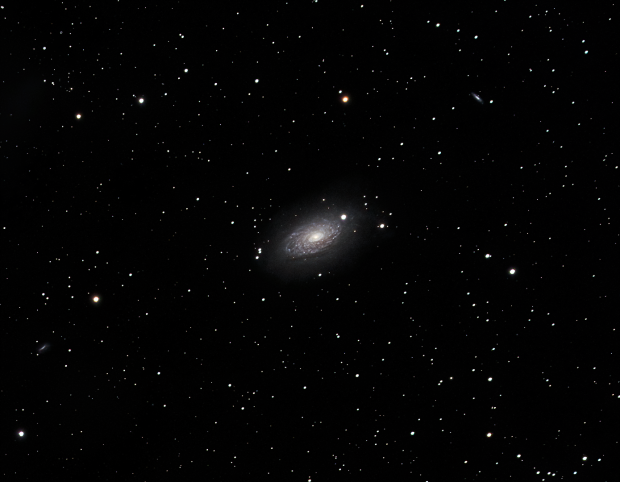
You don’t have to be an astronomer to appreciate Van Gogh’s wonderful evocation of the night sky in his 1889 painting Starry Night. He knew a thing or two about sunflowers too and I’ve often stopped by the National Gallery in Trafalgar Square to take a peep at his famous painting of them. However, it was still more than thirty years after completing these paintings that we first learned that such features as galaxies and the rest of the Universe even existed beyond our own Milky Way. Since then our knowledge of the cosmos has expanded considerably and today provides no end of imaging opportunities for the astrophotographer, subject to clear skies!
Having started the galaxy season with M106 and, given the excellent conditions that prevailed throughout much of Spring this year, I chose to return to the same area of the sky again to image M63, AKA the Sunflower Galaxy. M63 has a spiral form but with no apparent central bar and in visible light lacks large scale spiral structure, although two-arm structures are noticeable in near infra-red. Instead the dust lanes are extensively disrupted producing a patchy appearance and is thus classified as a flocculent galaxy – in this case looking something like a sunflower.
As previously discussed, most galaxies are a real challenge for my equipment but an earlier experiment indicated it might just be possible to image M63, the trick would be obtaining sufficient integration time. Fortunately three clear nights approaching a new moon in April provided over 8-hours of good subs, which I’m pleased to say resulted in a decent final image after all. The background sky is less busy than I would wish but there’s nice colour in the stars and also a few very small faint fuzzies on close inspection. Notwithstanding, M63 is clearly the star of the show (no pun intended) with the so-called flocculation clearly evident and numerous random dust lanes criss-crossing the entire galactic disc.
Although in 1924 Edwin Hubble’s recognition that galaxies, such as our own, existed outside the Milky Way, M63 was discovered by Pierre Méchain and catalogued by Charles Messier in 1779, long before Van Gogh’s paintings. He might conceivably have known of its presence therefore but not what it was and would surely be inspired to see and know about the Sunflower Galaxy as we do today.
| IMAGING DETAILS | |
| Object | M63, NGC 5055 AKA Sunflower Galaxy |
| Constellation | Canes Venatici |
| Distance | 29 million light-years |
| Size | 12.6’ x 7.2’ |
| Apparent Magnitude | +9.3 |
| Scope | William Optics GT81 + Focal Reducer FL 382mm f4.72 |
| Mount | SW AZ-EQ6 GT + EQASCOM computer control & Cartes du Ciel |
| Guiding | William Optics 50mm guide scope |
| + Starlight Xpress Lodestar X2 camera & PHD2 guiding | |
| Camera | ZWO1600MM-Cool mono CMOS sensor |
| FOV 2.65o x 2.0o Resolution 2.05”/pix Max. image size 4,656 x 3,520 pix | |
| EFW | ZWOx8 + ZWO LRGB & Ha OIII SII 7nm filters |
| Capture & Processing | Astro Photography Tool + PHD2 + Deep Sky Stacker & Photoshop CS3 |
| Image Location & Orientation | Centre RA 13h 15m 49.47” DEC +42o 01’ 45.62”
Top = North approx.. |
| Exposures | 30 x L 17 x R 18 x G 23 x B 12 x Ha x 300 sec
Total Time: 8hr 20 min |
| @ 139 Gain 21 Offset @ -20oC | |
| Calibration | 5 x 300 sec Ha + 10 X 300’ RGB Darks, 20 x 1/4000 sec Bias 10 x HaRGB Flats @ ADU 25,000 |
| Location & Darkness | Fairvale Observatory – Redhill – Surrey – UK Typically Bortle 5-6 |
| Date & Time | 14th 15th & 16th April 2020 @ +22.00h |
| Weather | Approx. <=8oC RH 60 – 70% 🌙 40% waning |

Pingback: Canine Capers | WATCH THIS SPACE(MAN)
Pingback: Reflections 2020 | WATCH THIS SPACE(MAN)